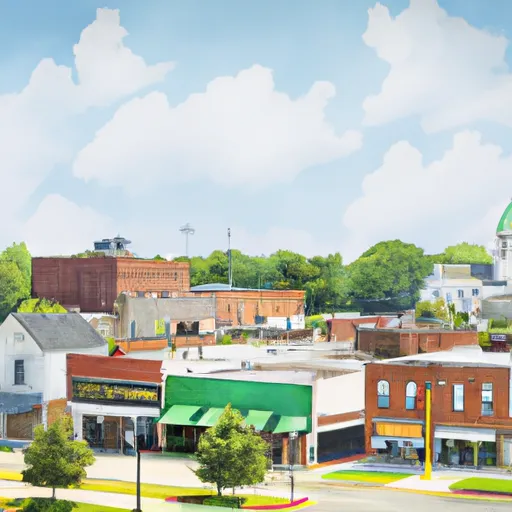-
 Snoflo Premium
Snoflo Premium
Get unlimited access to all our content
With no Ad interruptions! - Start Your Free Trial Login with existing account
Wheeler
Eden Index
Climate
7.9
•
Recreation
7.0
•
Community
3.1
•
Safeguard
6.4/10

Wheeler, Indiana is a small town located in Porter County. It experiences a continental climate with hot summers and cold winters. Summers are typically humid with temperatures averaging around 80°F (27°C), while winters can be cold with temperatures dropping to an average of 20°F (-6°C). Precipitation is evenly distributed throughout the year, with an annual average of around 40 inches.
The town is situated near several water bodies, including the Kankakee River and several smaller lakes. These hydrological features provide opportunities for fishing, boating, and kayaking. The Kankakee River State Park, located nearby, further enhances outdoor recreation options. The park offers hiking trails, camping facilities, and picnic areas, making it an ideal destination for nature enthusiasts.
Additionally, the area surrounding Wheeler is known for its picturesque forests and wildlife. Birdwatching, hunting, and nature photography are popular activities for visitors and residents alike. The natural beauty of Wheeler, with its diverse flora and fauna, offers a serene and tranquil atmosphere for those seeking an outdoor escape.
What is the Eden Index?
The Snoflo Eden Index serves as a comprehensive rating system for regions, evaluating their desirability through a holistic assessment of climate health, outdoor recreation opportunities, and natural disaster risk, acknowledging the profound impact of these factors on livability and well-being.
Climate Health Indicator (CHI): 7.9
Wheeler receives approximately
995mm of rain per year,
with humidity levels near 82%
and air temperatures averaging around
11°C.
Wheeler has a plant hardyness factor of
5, meaning
plants and agriculture in this region thrive during a short period during spring and early summer. Most
plants will die off during the colder winter months.
By considering the ideal temperature range, reliable water supplies, clean air, and stable seasonal rain or snowpacks, the Climate Health Indicator (CHI) underscores the significance of a healthy climate as the foundation for quality living.
A healthy climate is paramount for ensuring a high quality of life and livability in a region, fostering both physical well-being and environmental harmony. This can be characterized by ideal temperatures, reliable access to water supplies, clean air, and consistent seasonal rain or snowpacks.
Weather Forecast
Streamflow Conditions
Southwestern Lake Michigan
Area Rivers
Southwestern Lake Michigan
Snowpack Depths
Southwestern Lake Michigan
Reservoir Storage Capacity
Southwestern Lake Michigan
Groundwater Levels
Recreational Opportunity Index (ROI): 7.0
The Recreational Opportunity Index (ROI) recognizes the value of outdoor recreational options, such as parks, hiking trails, camping sites, and fishing spots, while acknowledging that climate plays a pivotal role in ensuring the comfort and consistency of these experiences.
Access to outdoor recreational opportunities, encompassing activities such as parks, hiking, camping, and fishing, is crucial for overall well-being, and the climate plays a pivotal role in enabling and enhancing these experiences, ensuring that individuals can engage in nature-based activities comfortably and consistently.
Camping Areas
| Campground | Campsites | Reservations | Toilets | Showers | Elevation |
|---|---|---|---|---|---|
| Lynnville Park | 70 | 465 ft | |||
| Sullivan County Park | 450 | 520 ft | |||
| Pike State Forest | 25 | 520 ft | |||
| Montgomery Rec Park | None | 515 ft | |||
| Greene - Sullivan State Forest | None | 521 ft | |||
| Prides Creek Co Park | None | 485 ft | |||
| Sunset City Park | None | 548 ft | |||
| Res 26 - Greene - Sullivan State Forest | 25 | 498 ft | |||
| Glendale State Fish and Wildlife Area | 120 | 495 ft | |||
| Lincoln State Park | 270 | 467 ft |
Nearby Ski Areas
Catastrophe Safeguard Index (CSI):
The Catastrophe Safeguard Index (CSI) recognizes that natural disaster risk, encompassing floods, fires, hurricanes, and tornadoes, can drastically affect safety and the overall appeal of an area.
The level of natural disaster risk in a region significantly affects safety and the overall livability, with climate change amplifying these risks by potentially increasing the frequency and intensity of events like floods, fires, hurricanes, and tornadoes, thereby posing substantial challenges to community resilience and well-being.
Community Resilience Indicator (CRI): 3.1
The Community Resilience Indicator (CRI) recognizes that education, healthcare, and socioeconomics are crucial to the well-being of a region. The CRI acknowledges the profound impact of these elements on residents' overall quality of life. By evaluating educational resources, healthcare accessibility, and economic inclusivity, the index captures the essential aspects that contribute to a thriving community, fostering resident satisfaction, equity, and social cohesion.

